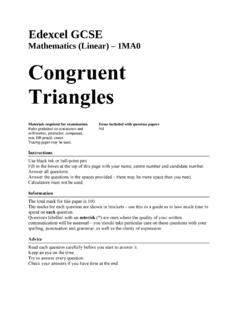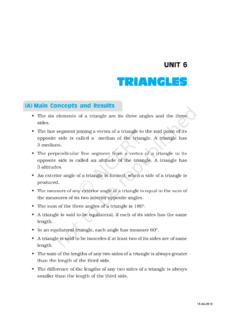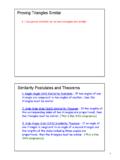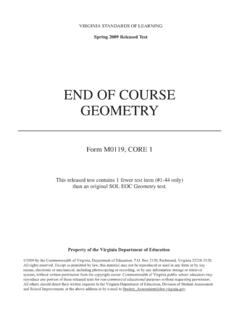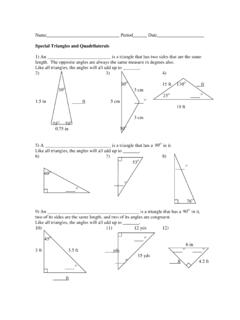Transcription of PROPERTIES OF QUADRILATERALS
1 PROPERTIES OF QUADRILATERALS PROPERTIES of Parallelograms In a parallelogram, 1. The parallel sides are parallel by definition. 2. The opposite sides are congruent . 3. The opposite angles are congruent . 4. The diagonals bisect each other. 5. Any pair of consecutive angles are supplementary. PROPERTIES of Rectangles In a rectangle, 1. All the PROPERTIES of a parallelogram apply by definition. 2. All angles are right angles. 3. The diagonals are congruent . PROPERTIES of Kites In a kite, 1. Two disjoint pairs of consecutive sides are congruent by definition. 2. The diagonals are perpendicular. 3. One diagonal is the perpendicular bisector of the other. 4. One of the diagonals bisects a pair of opposite angles. 5.
2 One pair of opposite angles are congruent . PROPERTIES of Rhombuses In a rhombus, 1. All the PROPERTIES of a parallelogram apply by definition. 2. Two consecutive sides are congruent by definition. 3. All sides are congruent . 4. The diagonals bisect the angles. 5. The diagonals are perpendicular bisectors of each other. 6. The diagonals divide the rhombus into four congruent right triangles. PROPERTIES of Squares In a square, 1. All the PROPERTIES of a rectangle apply by definition. 2. All the PROPERTIES of a rhombus apply by definition. 3. The diagonals form four isosceles right triangles. PROPERTIES of Isosceles Trapezoids In an isosceles trapezoid, 1. The legs are congruent by definition. 2. The bases are parallel by definition.
3 3. The lower base angles are congruent . 4. The upper base angles are congruent . 5. The diagonals are congruent . 6. Any lower base angle is supplementary to any upper base angle. Proving That a Quadrilateral is a Parallelogram Any one of the following methods might be used to prove that a quadrilateral is a parallelogram. 1. If both pairs of opposite sides of a quadrilateral are parallel, then it is a parallelogram (definition). 2. If both pairs of opposite sides of a quadrilateral are congruent , then it is a parallelogram. 3. If one pair of opposite sides of a quadrilateral are both parallel and congruent , then it is a parallelogram. 4. If the diagonals of a quadrilateral bisect each other, then the it is a parallelogram.
4 5. If both pairs of opposite angles of a quadrilateral are congruent , then it is a parallelogram. Proving That a Quadrilateral is a Rectangle One can prove that a quadrilateral is a rectangle by first showing that it is a parallelogram and then using either of the following methods to complete the proof. 1. If a parallelogram contains at least one right angle, then it is a rectangle (definition). 2. If the diagonals of a parallelogram are congruent , then it is a rectangle. One can also show that a quadrilateral is a rectangle without first showing that it is a parallelogram. 3. If all four angles of a quadrilateral are right angles, then it is a rectangle. Proving That a Quadrilateral is a Kite To prove that a quadrilateral is a kite, either of the following methods can be used.
5 1. If two disjoint pairs of consecutive sides of a quadrilateral are congruent , then it is a kite (definition). 2. If one of the diagonals of a quadrilateral is the perpendicular bisector of the other diagonal, then it is a kite. Proving That a Quadrilateral is a Rhombus To prove that a quadrilateral is a rhombus, one may show that it is a parallelogram and then apply either of the following methods. 1. If a parallelogram contains a pair of consecutive sides that are congruent , then it is a rhombus (definition). 2. If either diagonal of a parallelogram bisects two angles of the parallelogram, then it is a rhombus. One can also prove that a quadrilateral is a rhombus without first showing that it is a parallelogram. 3. If the diagonals of a quadrilateral are perpendicular bisectors of each other, then it is a rhombus.
6 Proving That a Quadrilateral is a Square The following method can be used to prove that a quadrilateral is a square: If a quadrilateral is both a rectangle and a rhombus, then it is a square. Proving That a Trapezoid is an Isosceles Trapezoid Any one of the following methods can be used to prove that a trapezoid is isosceles. 1. If the nonparallel sides of a trapezoid are congruent , then it is isosceles (definition). 2. If the lower or upper base angles of a trapezoid are congruent , then it is isosceles. 3. If the diagonals of a trapezoid are congruent , then it is isosceles.

